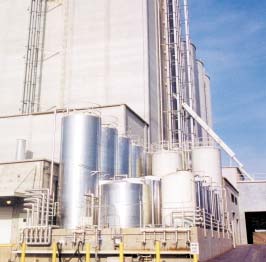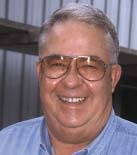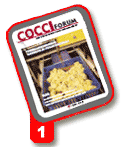'Business as Usual'
Switching to a coccidiosis vaccine doesn't have to cause headaches at the feedmill
 |
Implementing and managing a coccidiosis
vaccination program for
broilers is not the hassle or logistical
nightmare for feed mills that it's
sometimes cracked up to be.
In fact, today's computerized systems
and sophisticated management
make it tough to slip up. Even if mistakes
are made, it doesn't necessarily
spell disaster.
"In my experience, most modern
feed mills in the poultry industry are
quite capable of making routine feed
changes," necessitated by using a coccidiosis
vaccine, says Dr. H. David
Chapman, professor of poultry science,
University of Arkansas. "It all comes
down to quality control."
Feed mill managers who have managed
the switch agree.
"As long as the information is
entered properly into the computer system
and followed by dispatchers, problems
shouldn't result," says Doug
Helms, live operations manager for
Townsend's, Inc., in Arkansas.
"The same problems you could
encounter managing a coccidiosis vaccine
are the same that could arise no
matter what products you are using,
including in-feed coccidiostats."
Learning to Juggle

Bushong: 'Record keeping is minimized
when you don't have a coccidiostat
and are not running combination
products.'
|
Townsend's began using a live coccidiosis
vaccine, Coccivac-B, in broilers
5 years ago to help prevent resistance
and improve the response to in-feed
coccidiostats, Helms says. The hatchery
sprays each flock for coccidiosis for a
6-month period. During that time, in-feed
coccidiostats are withheld from
the starter, grower and finisher feeds
for those flocks. When the hatchery
stops spraying for coccidiosis, in-feed
coccidiostats are provided in the feed.
"Switching from a coccidiostat to a
coccidiosis vaccine requires some
effort," notes Helms, "but no more than
any other change at our feed mill,"
which produces about 4,500 tons of
broiler feed per week.
Dr. Linnea Newman, a poultry consulting
veterinarian with Schering-Plough
Animal Health, says there are two
major areas of concern during transition
to and from a coccidiosis vaccination
program. First, there is a concern
that vaccinated birds will receive feed
containing a coccidiostat that would
destroy the oocysts from the live vaccine
and prevent birds from developing
immunity. The second concern is that
unvaccinated birds will receive feed
without a coccidiostat, leaving them
open to field challenge.
"The greatest focus needs to be on
the starter ration. Vaccine-stimulated
immunity to coccidial organisms
requires two 7-day cycles for E. ace-vulina and E. maxima, and three
cycles for E. tenella. If the feed mill can
get the starter ration delivered correctly,
most serious problems can be avoided,"
she says.
Although normal practice dictates
that feed should not be left on the farm
for long periods of time, Dr. Newman
says it may be necessary to deliver the
entire 1.5 to 2 pounds per bird of
starter feed to the bins of the last farms
that receive birds before the transition
is made. This allows the mill to make a
clean break and begin delivering the
new starter to the first farms after the
change.
"High-volume grower rations can't
be delivered all at once, but a single
mistaken delivery of grower feed on a
given farm is not as likely to cause a
problem for vaccinated birds," she says.
Unvaccinated birds with a mistaken
delivery of grower feed may need
amprolium treatment, but only if the
field challenge level is high, Dr.
Newman adds.
It's Manageable
"Concerns about making the transition
to and from a vaccination program are
legitimate," she adds, "but we've found
that managing feed for a coccidiosis
vaccine program is business as usual. If
a mistake occurs "and it is rare when
one does "it's manageable."
Poultry scientists agree that the
worst-case scenario would be failing to
provide an in-feed coccidiostat to
unvaccinated birds.
"I think you'll get away with it for
one flock," says Dr. Chapman, "unless
there are other conditions and diseases
that exacerbate coccidiosis. Anticoccidials
often are used as an insurance policy
anyway to prevent, not treat coccidiosis."
Adds Dr. Tim Cherry, poultry veterinarian
at Stephen F. Austin State
University, Nacogdoches, Tex., "The
worst-case scenario is that you'd lose
some birds and have to medicate the
water. You'd also have to remove the
old feed, put in the new feed with a
coccidiostat and correct for the next
cycle."
Keep it Simple
To simplify the process and help assure
mistakes don't happen, Townsend's
maintains the same schedule for all its
farms. "For instance, when switching
from the vaccine to the in-feed treatment,
we pick a date," Helms explains.
"After that date, all farms get unvaccinated
chicks. The feed mill knows the
feed must contain a coccidiostat."
The procedure is similar at
Mississippi-based Peco Farms, LLC,
which also rotates a coccidiosis vaccine
to prevent the development of resistance
to the in-feed products, says Gary
Nelson, feed manager.
"We have a cutoff date for the
hatchery when it stops spraying for
coccidiosis," he says. "There is one person
at the feed mill assigned to notify
everyone about that date, and chicks
produced subsequently must have an
anticoccidial in the starter, grower and
finisher feeds."
The transition does require that
feeds with and without an anticoccidial
be kept in stock, but it hasn't been difficult,
Nelson says.
"We work with about 100 growers,
but it's not confusing for the feed mill.
The feed dispatcher keeps up with the
cycle on paper "and it's in his head,"
he says. "Some people would say that
switching to the vaccine is a big deal,
but it's not."
Dr. Rex Bushong, a consulting nutritionist
from San Angelo, Tex., who
works with Peco, thinks switching to a
vaccine will actually make life easier at
the feed mill.
"Record keeping is minimized when
you don't have a coccidiostat and are
not running combination products," he
says. "Operations may experience
some confusion in the beginning, but
the benefits of switching to a vaccine
might help them out long term."
Source: CocciForum Issue No.1, Schering-Plough Animal Health.







